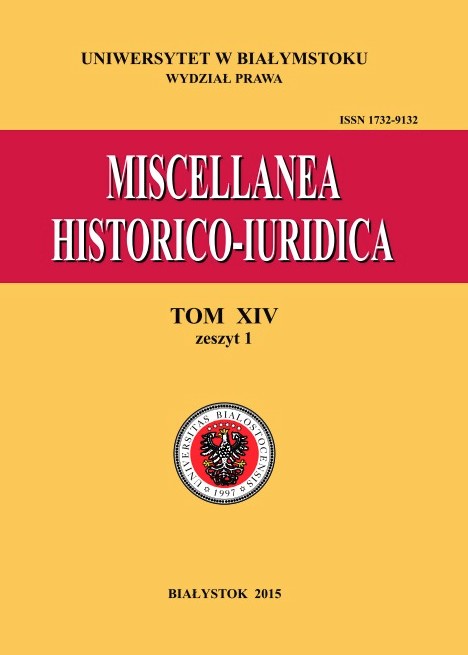Fibrosa S.A. v. Fairbairn Lawson Combe Barbour Ltd (1942). The Company from Kresy (Polish Eastern Borderlands) Before the House of Lords
Keywords:
legal history, England, English law, common law, restitution, unjust enrichmentAbstract
The paper discusses Fibrosa S.A. v. Fairbairn Lawson Combe Barbour Ltd (1942), a case considered as one of several landmark cases in the English law of restitution. What was at stake in litigation before the House of Lords was whether a Polish plaintiff should recover a prepayment transferred pursuant to a contract that had become frustrated because of the outbreak of war in 1939. The lords had to decide on the application of two potentially dissonant doctrines – frustration and total failure of consideration. But what made the Fibrosa case famous was an obiter dictum delivered by lord Wright. This eminent judge declared that English law should provide remedies for unjust enrichment. That is the very reason why the case is still being cited by the lawyers today.
References
Rozporządzenie Prezydenta Rzeczypospolitej z dnia 27 października 1933 r. – Kodeks zobowiązań (Dz.U. nr 82, poz. 598).
Ustawa z dnia 23 kwietnia 1964 r. – Kodeks cywilny (Dz.U. nr 16, poz. 93).
Law Reform (Frustrated Contracts) Act (1943) 6&7 George VI c. 40.
Rozporządzenie Parlamentu Europejskiego i Rady (WE) nr 593/2008 z dnia 17 czerwca 2008 r. w sprawie prawa właściwego dla zobowiązań umownych (Rzym I).
Trading with the Enemy Act (1939) 2&3 George VI c. 86.
Ustawa z dnia 2 sierpnia 1926 r. o prawie właściwem dla stosunków prywatnych międzynarodowych.
Appleby v. Myers (1867) L.R. 2 C.P. 651.
BP Exploration Co (Libya) v. Hunt (No 2) (1979) 1 W.L.R. 783.
Brook’s Wharf and Bull Wharf, Ltd. v. Goodman Bros.(1937) 1 K.B. 534.
Cadogan Petroleum Holdings Ltd v. Global Process Systems LLC (2013) 1 C.L.C.733–734.
Cantiare San Rocco S.A. v. Clyde Shipbuilding and Engineering Co. Ltd. (1924) A.C.227.
Chandler v. Webster (1904) 1 K.B. 493.
Dutch v. Warren (1720) Strange I 406.
Fibrosa Spolka Akcyjna v. Fairbairn Lawson Combe Barbour Ltd (1943) A.C. 32.
French Marine v. Compagnie Neapolitaine d’Eclairage et de Chauffage par le Gas (1921) 2 A.C. 494.
Great Peace Shipping Ltd v. Tsavliris Salvage (International) Ltd (2002) EWCA Civ 1407.
Kiriri Cotton Co. v. Dewani (1960) A.C. 192.
Krell v. Henry (1903) 2 K.B. 740.
Lipkin Gorman v. Karpnale Ltd (1991) 2 A.C. 548.
Giedo van der Garde BV v. Force India Formula One Team Ltd (2010) EWHC 2373.
Greater Manchester Police v. Wigan Athletic Afc Ltd (2007) EWHC 3095 (Ch).
Kleinwort Benson Ltd v. Glasgow City Council (1997) 3 W.L.R.923, (1999) 1 A.C. 186.
Kleinwort Benson Ltd v. Lincoln City Council (1998) 3 WLR 1095.
London Street Tramways v. London City Council (1898) A.C. 375.
Moses v. MacFerlan (1760) 2 Burrow 1005.
Practical Statement (1966) 3 All E.R. 77.
Rowe v. Vale of White Horse (2003) EWHC 388.
Russkoe Obschestvo d’lia Izgstovlenia Snariadov l’voennick Pripassov v. John Stirk & Sons (1922), Ld. 10 Ll.L.Rep.214.
Sempra Metals Limited (formerly Metallgesellschaft Limited) v. Her Majesty’s Commissioners of Inland Revenue and another (2007) 3 W.L.R.407–408.
Stocznia Gdanska S.A. v. Latvian Shipping Co. Latreefer Inc. and Others (1998) 1 Lloyd’s Rep. 609.
Taylor v. Caldwell (1863) 3 B. & S. 826.
Toovey & Anor, R (on the application of) v. Law Society (2002) EWHC 391.
United Australia v. Barclays Bank (1941) A.C. 1.
Westdeutsche Landesbank Girozentrale v. Islington London Borough Council (1996) 2 A.C. 710.
Whincup v. Hughes (1871) L.R. 6 C.P. 78.
Woolwich Equitable Building Society v. IRC (1993) 1 A.C. 80.
Atiyah P., Smith S., Atiyah’s Introduction to the Law of Contract, Oxford 2005.
Birks P., Unjust Enrichment, Oxford 2004.
Burke G.B., The Proper Law of a Contract for the Sale of Goods, Arbitration 1924.
Burrows, A Casebook on Contract, Oxford 2009.
Denning A.T., „The Law of Restitution”, by Robert Goff, Gareth Jones, London 1966, (recenzja), “LQR” 1967, nr 83.
Duxbury N., Lord Wright and Innovative Traditionalism, “University of Toronto Law Journal” 2009, nr 59.
Edelman J., Money Had and Received: Modern Pleading of an Old Count, “Restitution Law Review” 2000, nr 8.
Evans-Jones R., Roman Law in Scotland and England and the Developement of one Law for Britain, “The Law Quarterly Review” 1999, nr 115.
Evans-Jones R., Roman Law in Britain, [w:] Questiones Iuris. Festschrift fur Joseph Georg Wolf zum 70. Geburtstag, red. U. Manthe, C. Krampe, Berlin 2000.
Goff R., Jones G., The Law of Restitution, London 2002.
Halberda J., Historia zobowiązań quasi-kontraktowych w common law, Kraków 2012.
Halberda J., Zasada bezpodstawnego wzbogacenia w prawie angielskim, „Studia Prawa Prywatnego” 2014, nr 2.
Hedley S., Restitution in English Common Law, [w:] The Oxford International Encyclopedia of Legal History, red. S.N. Katz, t. V, Oxford 2009.
Korporowicz Ł.J., Prawo rzymskie w wybranych orzeczeniach Izby Lordów w latach 1999–2009, Z dziejów prawa, t. 4 (12), Katowice 2011.
Landmark cases in the Law of Restitution , red. Ch. Mitchell, P. Mitchell, Oxford 2006.
Litewski W., Słownik encyklopedyczny prawa rzymskiego, Kraków 1998.
Marzec Ł., Sprawa Fibrosa vs Fairbairn. Polska spółka, Izba Lordów i prawo rzymskie, „Zeszyty Prawnicze UKSW” 2007, nr 7/1.
McInnes M., The Reason to Reverse: Unjust Factors and Juristic Reasons, „Boston University Law Review” 2012, nr 92.
McMeel G., Casebook on restitution, London 1996.
Mitchell P., Fibrosa Spolka Akcyjna v Fairbairn Lawson Combe Barbour, Limited (1942), [w:] Landmark cases in the Law of Restitution, red. Ch. Mitchell, P. Mitchell, Oxford 2006.
Sobczyk M., Zamierzony cel świadczenia nie został osiągnięty (condictio ob rem). Przykład przydatności myśli jurystów rzymskich dla wykładni przepisów kodeksucywilnego, „Kwartalnik Prawa Prywatnego” 2004, nr 4.
Strange J., Reports of Adjudged Cases In the Courts of Chancery, King’s Bench, Common Pleas and Exchequer, From Trinity Term in the second Year of King George I To Trinity Term in the twenty-first Year of King George II, Savoy (London) 1755.
Wilmot-Smith F., Reconsidering “total” failure, “Cambridge Law Journal” 2013, nr 72.







